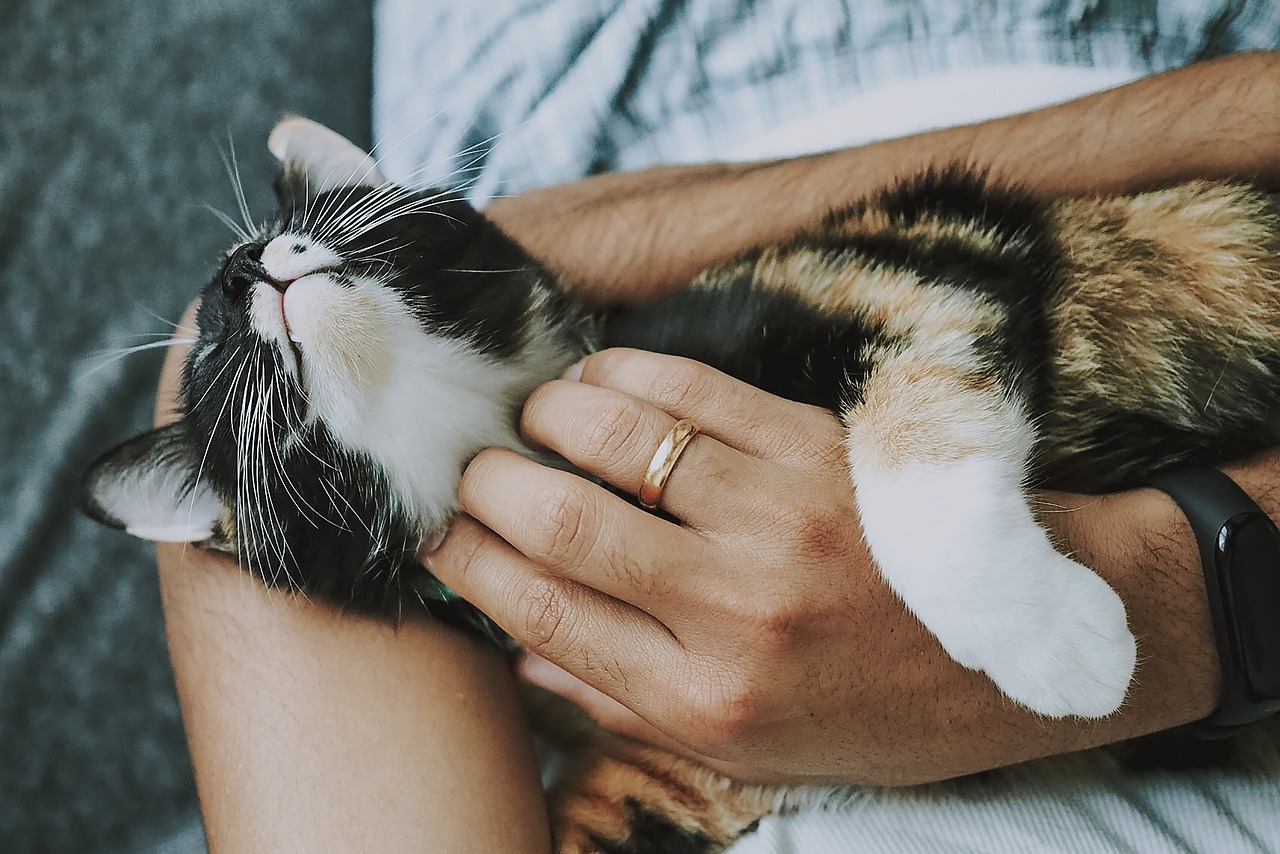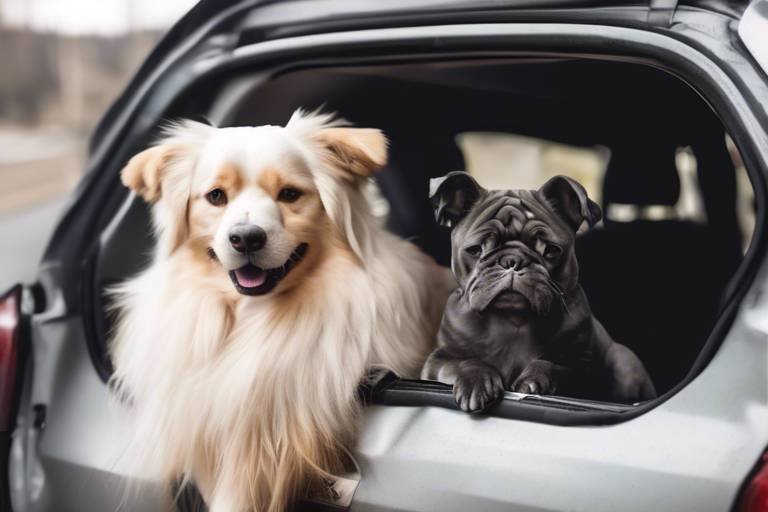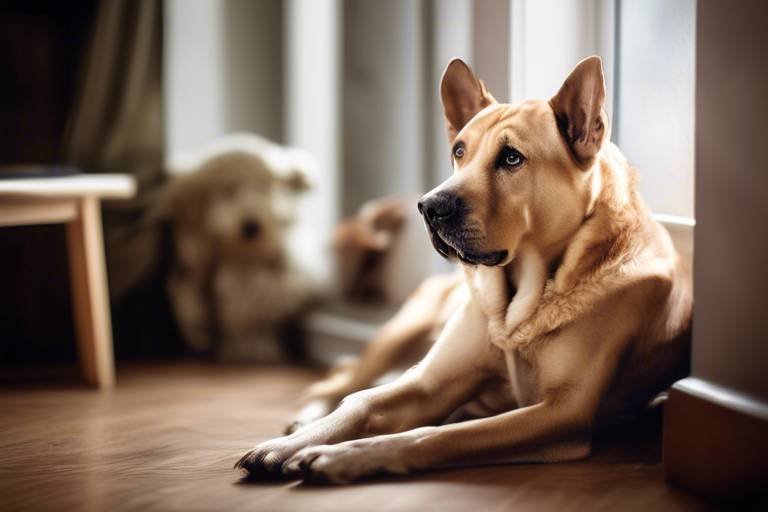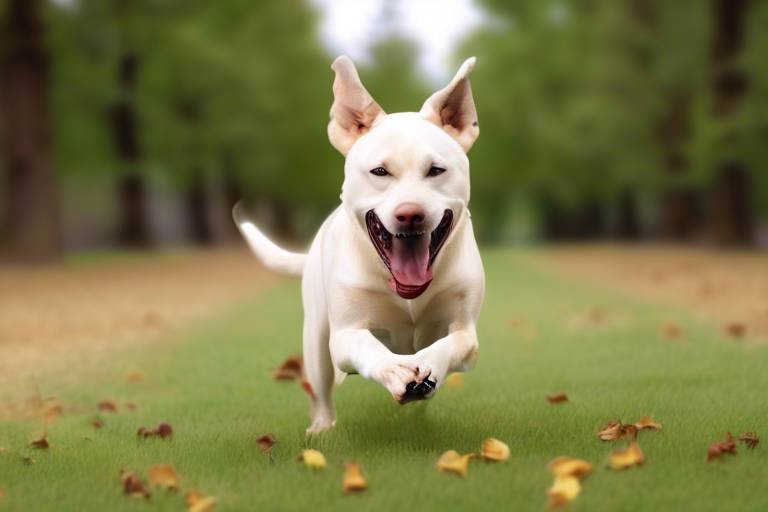How to Help Your Pet With Travel Anxiety
Traveling with your furry friend can be one of the most rewarding experiences, but it can also be a source of significant stress for both of you. Just like humans, pets can experience anxiety when faced with new environments and situations. This anxiety can manifest in various ways, such as excessive barking, trembling, or even refusing to eat. So, how do you ensure a smooth journey for both you and your beloved pet? In this article, we will explore effective strategies to alleviate travel anxiety in pets, ensuring a more enjoyable experience for all involved. From understanding the signs of anxiety to preparing your pet for travel, we’ve got you covered with tips, techniques, and insights that will help you create a stress-free travel experience.
Understanding travel anxiety is the first step in helping your pet feel more comfortable during trips. Just imagine being taken from your cozy home and thrust into a noisy, unfamiliar place; it can be overwhelming! Common signs of travel anxiety in pets include:
- Excessive barking or whining
- Trembling or shaking
- Refusal to eat or drink
- Destructive behavior, such as scratching or chewing
- Hiding or trying to escape
Recognizing these signs early can help you address your pet's fears and make necessary adjustments to your travel plans. It's essential to consider the root causes of their anxiety, which can range from a lack of exposure to travel experiences to negative past encounters. By understanding your pet's emotional state, you can implement strategies that cater to their specific needs.
Preparation is key when it comes to reducing anxiety. Think of it as a rehearsal before the big show! Familiarizing your pet with travel gear, such as carriers or harnesses, and practicing short trips can help them adjust to the idea of traveling. Start by taking your pet on short car rides to get them used to being in a moving vehicle. Gradually increase the duration of these trips while ensuring that they associate the experience with positive reinforcement—think treats, praise, and playtime!
Selecting an appropriate carrier can significantly impact your pet's comfort. Consider their size, preferences, and safety features. A carrier that feels like a cozy den can make a world of difference. Ensure that it's well-ventilated, easy to clean, and secure. Remember, the right carrier will not only keep your pet safe but also provide them with a sense of security during the journey.
Gradual introduction to the carrier can help ease anxiety. Allow your pet to explore it at home, associating it with positive experiences like treats and playtime. You might even want to leave the carrier open in a familiar space so they can investigate it at their own pace. The goal is to transform the carrier from a dreaded travel box into a safe haven where they feel comfortable and relaxed.
Bringing familiar items, such as their favorite blanket or toy, can provide comfort during travel. These items create a sense of home, helping to reduce anxiety and promote relaxation. Just like a child needs their favorite stuffed animal during a long car ride, your pet will appreciate having something that smells like home. It’s the little things that can make a big difference!
Implementing calming techniques can help soothe anxious pets. Techniques such as deep pressure therapy, gentle massage, or calming music can create a more tranquil environment during travel. You might be surprised at how much a gentle rub behind the ears can help your pet relax. Additionally, consider playing soft music or using calming pheromone sprays designed to ease anxiety. Think of it as creating a peaceful oasis amidst the chaos of travel.
In some cases, medication or natural supplements may be necessary to manage severe anxiety. Consult your veterinarian for recommendations tailored to your pet's specific needs and health conditions. Don't hesitate to discuss your concerns with a professional; they can provide valuable insights and options that you may not have considered.
Before traveling, it's always wise to consult your veterinarian to discuss potential medications or supplements that could help ease your pet's anxiety. They can recommend safe and effective options, ensuring your pet's safety and well-being throughout the journey. Just like you wouldn’t embark on a long trip without checking your vehicle, don’t overlook the importance of your pet's health!
Natural remedies, such as pheromone diffusers or herbal supplements, can provide additional support for anxious pets. Explore various options to find what works best for your furry friend. Some pet owners have reported success with products containing ingredients like valerian root or chamomile, which can have calming effects. Remember, each pet is unique, so what works for one may not work for another.
A calming travel environment can significantly impact your pet's comfort. Ensuring proper ventilation, minimizing noise, and maintaining a comfortable temperature are essential for reducing anxiety during trips. Consider using car seat covers that can help absorb sound and provide a familiar texture for your pet to lie on. Additionally, make frequent stops to allow your pet to stretch their legs and relieve themselves. It’s all about making the journey as enjoyable as the destination!
Q: How can I tell if my pet is anxious during travel?
A: Look for signs such as excessive barking, trembling, hiding, or destructive behavior. If your pet seems unusually restless or agitated, they may be experiencing anxiety.
Q: Can I use medication to help my pet with travel anxiety?
A: Yes, medications can be effective for severe anxiety. Always consult your veterinarian for recommendations tailored to your pet's specific needs.
Q: What natural remedies can I try for my pet's anxiety?
A: Natural remedies like pheromone diffusers, calming supplements, or even gentle massage can help soothe anxious pets. Always consult with your vet before trying new treatments.
Q: How can I create a comfortable travel environment for my pet?
A: Ensure proper ventilation, minimize noise, and maintain a comfortable temperature in the vehicle. Bring familiar items like blankets or toys to help your pet feel at ease.

Understanding Travel Anxiety in Pets
Travel anxiety in pets is a common issue that can affect both dogs and cats, leading to distressing behaviors and discomfort during trips. Just like humans, our furry friends can experience a range of emotions, and travel often brings about feelings of fear and uncertainty. It's essential to recognize the signs of travel anxiety, which can manifest in various ways, such as:
- Excessive barking or meowing: This vocalization can be a clear signal that your pet is feeling stressed.
- Trembling or shaking: Physical signs of anxiety may include trembling, which indicates fear.
- Pacing or restlessness: If your pet can’t seem to settle down, it’s a good indication they are anxious.
- Avoidance behaviors: Hiding or trying to escape can signal that your pet is overwhelmed.
Understanding these signs is crucial for addressing your pet's fears and ensuring their comfort during trips. Various factors can contribute to travel anxiety, including:
- Previous negative experiences: If your pet has had a bad experience while traveling, they may associate travel with fear.
- Changes in routine: Pets thrive on routine, and any disruption can lead to anxiety.
- New environments: Traveling introduces pets to unfamiliar sights, sounds, and smells, which can be overwhelming.
By recognizing these signs and understanding the underlying causes, pet owners can take proactive steps to alleviate their furry companions' anxiety. It's essential to approach the situation with empathy and patience, as your pet’s anxiety is a genuine concern for them. Think of it this way: just as a child might feel anxious before their first day of school, your pet may feel similarly about embarking on a journey. The goal is to create a positive travel experience that helps them associate travel with fun rather than fear.

Preparing Your Pet for Travel
When it comes to ensuring a smooth travel experience for both you and your furry friend, preparation is key. Just like we need to pack our bags and plan our routes, our pets require a bit of preparation to help them adjust to the idea of traveling. Imagine how overwhelming it can be for them when they suddenly find themselves in a moving vehicle or at an unfamiliar place. To ease their anxiety, start by familiarizing your pet with their travel gear well in advance. This could mean letting them explore their carrier or harness at home, allowing them to get used to these items in a safe and familiar environment.
Additionally, practicing short trips can significantly help in reducing their travel anxiety. Begin by taking your pet on short drives around the neighborhood. This will help them associate the car with positive experiences rather than fear. Gradually increase the duration of these trips, making sure to reward them with treats and affection. This approach not only builds their confidence but also creates a sense of routine, which can be comforting for your pet.
One of the most crucial aspects of preparing your pet for travel is selecting the right carrier. The carrier should not only be safe but also comfortable for your pet. Consider their size, as a cramped space can lead to discomfort and anxiety. A good rule of thumb is to choose a carrier that allows your pet to stand up, turn around, and lie down comfortably. Additionally, think about your pet's preferences. Some pets feel more secure in a soft-sided carrier, while others might prefer a hard-shell option. Ensure that the carrier has proper ventilation and is easy to clean, as accidents can happen!
To help your pet feel more at ease with their carrier, introduce it gradually. Start by placing the carrier in a common area of your home where your pet spends time. Allow them to explore it at their own pace. You can make the carrier more inviting by placing their favorite blanket or toy inside, turning it into a cozy retreat. Encourage your pet to enter the carrier by offering treats or engaging in playtime nearby. This positive reinforcement will help them associate the carrier with good experiences, making it less intimidating when it’s time to travel.
Bringing familiar items along for the ride can also provide a sense of comfort for your pet. Items such as their favorite blanket, a toy, or even a piece of your clothing can create a sense of home, helping to reduce anxiety and promote relaxation. These familiar scents and textures can be incredibly soothing for your pet, especially in unfamiliar environments. Just like we might carry a memento from home when traveling, our pets benefit from their comfort items too.
Implementing calming techniques can also play a crucial role in soothing anxious pets during travel. Techniques such as deep pressure therapy, gentle massage, or playing calming music can create a more tranquil environment. You might even consider using a calming spray or diffuser designed for pets, which can have a soothing effect. Remember, the goal is to create an atmosphere that feels safe and secure, making the journey enjoyable for both you and your furry companion.
Choosing the Right Carrier
When it comes to traveling with your pet, one of the most crucial decisions you'll make is selecting the right carrier. Think of the carrier as your pet's home away from home; it needs to be a safe haven that provides comfort and security during the journey. To ensure your furry friend feels at ease, consider the following factors:
Size Matters: The carrier should be appropriately sized for your pet. A carrier that is too small can make your pet feel cramped and anxious, while one that is too large might not provide the sense of security they need. As a general rule, your pet should be able to stand up, turn around, and lie down comfortably in the carrier. Measure your pet before making a purchase to find the ideal fit.
Material and Design: Carriers come in various materials, including soft-sided, hard-sided, and collapsible options. Soft-sided carriers are often more comfortable and easier to carry, but hard-sided carriers provide better protection during travel. Choose a design that not only meets your pet's needs but also fits your travel style. For example, if you're flying, check airline regulations to ensure your carrier meets their requirements.
Ventilation and Visibility: A well-ventilated carrier is essential for your pet's comfort. Look for carriers with mesh windows or vents that allow for airflow. This will help prevent overheating and keep your pet calm. Additionally, a design that offers visibility can help your pet feel less isolated, as they can see you and their surroundings.
Safety Features: Your pet's safety should always be a top priority. Ensure that the carrier has secure latches and zippers that cannot be easily opened by your pet. Some carriers come equipped with safety straps that can be attached to your car's seatbelt, preventing the carrier from sliding around during travel.
To summarize, here are some key points to consider when choosing the right carrier for your pet:
- Ensure the carrier is the right size for your pet.
- Choose a material that balances comfort and protection.
- Look for good ventilation and visibility options.
- Prioritize safety features to keep your pet secure.
By carefully considering these factors, you can select a carrier that not only meets your pet's needs but also makes your travel experience smoother and more enjoyable. Remember, the right carrier can turn a potentially stressful journey into a positive adventure for both you and your furry companion!
Introducing the Carrier Gradually
Introducing your pet to their travel carrier should be a gentle and gradual process. Think of it as a little adventure rather than a chore. The goal here is to create positive associations with the carrier so that your furry friend feels safe and comfortable when it's time to travel. Start by placing the carrier in a familiar area of your home, like the living room or your pet's favorite spot. This way, they can see it without feeling threatened by it.
Next, allow your pet to explore the carrier at their own pace. Leave the door open and encourage them to sniff around, and even step inside if they feel inclined. You might want to entice them with treats or their favorite toy. This can transform the carrier from a strange object into a fun place. You can also make it cozier by adding their favorite blanket or a piece of your clothing, which can help them feel more at home.
Once your pet seems comfortable with the carrier being in the room, it's time to take it a step further. Start with short sessions where you gently close the door for just a few seconds while they’re inside. Gradually increase the time they spend in the carrier with the door closed, but always ensure to reward them with treats and praise afterward. This will reinforce positive behavior and help them associate the carrier with good experiences.
Additionally, consider using some calming techniques during this process. Playing soft music or using a pheromone spray can help create a relaxing atmosphere. Remember, patience is key! Some pets may take longer to adjust than others, and that’s perfectly normal. Keep the sessions short and positive, and soon enough, your pet will see the carrier as their little sanctuary, ready for your next adventure together.
- How long should I take to introduce the carrier? It's best to take your time, allowing several days to a week for your pet to feel comfortable with the carrier.
- What if my pet refuses to enter the carrier? Try enticing them with treats or toys, and ensure the carrier is placed in a familiar environment.
- Can I use a carrier for different types of pets? Yes, but ensure the carrier is suitable for the size and type of your pet, providing enough space for them to move comfortably.
- What should I do if my pet shows signs of anxiety in the carrier? Gradually reintroduce the carrier, using positive reinforcement, and consider calming techniques or consulting a veterinarian if anxiety persists.
Comfort Items for the Journey
When it comes to traveling with your pet, ensuring their comfort is paramount. Just like how we might pack our favorite snacks or a cozy blanket for a long road trip, your furry friend deserves the same level of consideration. Bringing familiar items can work wonders in alleviating their anxiety during travel. Imagine how you would feel if you were in an unfamiliar environment without your favorite belongings—pretty unsettling, right?
One of the most effective ways to create a sense of security for your pet is by including their favorite blanket or toy in your travel gear. These items are more than just objects; they carry the scent of home and the warmth of comfort. When your pet snuggles up with their blanket or plays with their trusted toy, it can evoke feelings of safety and relaxation, making the journey feel less daunting.
Additionally, consider packing some comfort items that can help soothe your pet during the trip. Here are a few suggestions:
- Familiar Bedding: A piece of bedding or a small cushion can provide a cozy spot for your pet to rest.
- Favorite Toys: Toys that they love can keep them occupied and distracted from the stress of travel.
- Treats: Bringing along some of their favorite treats can be a great way to reward them and create positive associations with travel.
Moreover, consider using a calming spray or a pheromone diffuser that can be applied to their blanket or carrier. These products can help create a calming atmosphere, mimicking the comforting scents of home. Think of it as a soothing aroma that wraps around your pet like a warm hug, helping to ease their nerves.
Ultimately, the goal is to create a travel environment that feels as familiar and safe as possible for your pet. By thoughtfully selecting and packing comfort items, you can significantly reduce their anxiety and make the journey more enjoyable for both of you. Remember, a happy pet means a happy traveler!
Q: What items should I bring for my pet during travel?
A: It's best to bring familiar items like their favorite blanket, toys, and treats. These can help soothe their anxiety and create a sense of comfort.
Q: How can I make my pet feel safe in a new environment?
A: Use familiar items that carry their scent, such as bedding or toys, and consider using calming sprays or pheromone diffusers to create a relaxing atmosphere.
Q: Should I consult my veterinarian before traveling with my pet?
A: Yes, consulting your veterinarian is a good idea to discuss any potential medications or supplements that can help ease your pet's anxiety during travel.
Calming Techniques for Travel
Traveling with your pet can be an adventure, but it can also be a source of anxiety for both of you. To help your furry friend feel more at ease during your journey, it's essential to implement some effective calming techniques. These methods can create a soothing atmosphere, allowing your pet to relax and enjoy the ride.
One of the most effective techniques is deep pressure therapy. This involves applying gentle pressure to your pet's body, similar to a comforting hug. You can achieve this by using a snug-fitting vest designed for anxiety relief, or simply by gently holding your pet close during travel. Many pets find this pressure reassuring, akin to being swaddled, which can significantly reduce their stress levels.
Another approach is to employ gentle massage. Just like humans, pets can benefit from a soothing touch. Spend a few minutes before and during the journey massaging your pet's neck, back, or paws. This not only distracts them from their anxiety but also promotes relaxation through the release of endorphins. Think of it as a mini spa day on the go!
Additionally, consider playing calming music during your travels. Studies have shown that certain types of music can have a calming effect on dogs and cats. Create a playlist of soft, soothing melodies or find specially designed playlists for pets. The familiar sound can act as a comforting backdrop, drowning out the noise of the outside world and helping your pet feel more secure.
It's also beneficial to establish a consistent travel routine. Just like we thrive on predictability, pets do too. Try to maintain a similar schedule for meals, bathroom breaks, and rest times during your travels. This predictability can help alleviate anxiety as your pet knows what to expect. Consider setting a travel itinerary that includes regular stops for stretching and bathroom breaks, which can help both of you recharge.
Incorporating these calming techniques can make a world of difference for your pet's travel experience. Remember, every pet is unique, so it might take some experimentation to find the techniques that work best for your furry companion. By prioritizing their comfort and well-being, you can transform travel time from a source of stress into a delightful bonding experience.
- What are the signs of travel anxiety in pets? Look for behaviors such as excessive barking, trembling, drooling, or attempts to escape. Some pets may also refuse to eat or show signs of distress.
- How can I prepare my pet for a long journey? Start with short trips to help your pet acclimate. Gradually increase the duration and ensure they have positive experiences associated with travel.
- Are there specific calming products I can use? Yes, consider using calming vests, pheromone diffusers, or natural supplements. Always consult with your veterinarian before introducing new products.
- How can I create a comfortable travel environment for my pet? Ensure proper ventilation, minimize noise, and maintain a comfortable temperature inside the vehicle. Bringing familiar items can also help ease anxiety.

Using Medication and Supplements
When it comes to managing your pet's travel anxiety, sometimes a little extra help is needed. Just like humans, pets can experience overwhelming stress during travel, and while there are many strategies to alleviate this, medication and supplements can play a crucial role for some furry friends. It’s essential to approach this topic with care and consultation, as each pet is unique and may respond differently to various treatments.
Before you even think about reaching for the medicine cabinet, it's important to have a chat with your veterinarian. They can provide valuable insights into your pet’s specific needs and recommend the best course of action. Some pets might benefit from prescription medications, while others may find relief with natural supplements. It’s like choosing between a comfort blanket and a warm hug; both can provide comfort, but one might just fit better in certain situations.
Here’s a brief overview of some common options:
| Type | Purpose | Notes |
|---|---|---|
| Prescription Medications | Help reduce severe anxiety | Requires vet consultation; may have side effects |
| Natural Supplements | Promote relaxation and calmness | Generally safer, but still consult vet |
| Pheromone Products | Calm pets with synthetic pheromones | Available in sprays or diffusers |
Prescription medications can be a lifeline for pets that experience intense anxiety; however, they should always be viewed as a last resort after trying behavioral techniques and natural remedies. These medications can range from anti-anxiety drugs to sedatives, and they often require careful monitoring to ensure your pet's safety. Think of it like a safety net—sometimes it’s necessary, but it’s best to try to walk the tightrope without it first.
On the other hand, natural supplements have gained popularity as a gentler alternative. Options like melatonin, CBD oil, or L-theanine can help soothe anxious pets without the side effects commonly associated with prescription medications. Many pet owners have found success with these natural remedies, but it’s still vital to consult your vet to find the right fit for your furry companion.
Additionally, pheromone diffusers or sprays designed specifically for pets can create a calming environment during travel. These products mimic the natural calming pheromones that pets produce, helping to ease their anxiety. It’s a bit like wrapping your pet in a comforting cloud of tranquility, making the journey feel a little less daunting.
Ultimately, the key to successfully managing your pet's travel anxiety lies in understanding their individual needs and preferences. With the right combination of techniques, medications, and a lot of love, you can help your pet feel more secure, turning stressful trips into enjoyable adventures together.
- What should I do if my pet shows signs of anxiety during travel?
It's important to remain calm and address their needs. Speak softly to them, and if necessary, consider using calming techniques or medications as discussed with your vet. - Are there any side effects to using anxiety medications for pets?
Yes, some pets may experience side effects like drowsiness or gastrointestinal issues. Always monitor your pet closely and consult your vet if you notice any unusual behavior. - Can I use human anxiety medications for my pet?
Absolutely not! Human medications can be dangerous for pets. Always consult your veterinarian for appropriate medications specifically designed for animals.
Consulting Your Veterinarian
When it comes to managing your pet's travel anxiety, one of the most important steps you can take is . Your vet is not only knowledgeable about your pet's health but also understands the nuances of their behavior. Before embarking on any journey, it's crucial to have a candid discussion about your pet's anxiety levels and the best ways to address them. This conversation can help you identify the root causes of their anxiety, whether it's related to past experiences, the type of travel, or even their temperament.
During your consultation, be sure to mention specific signs that indicate your pet is anxious, such as:
- Excessive barking or howling
- Trembling or shaking
- Loss of appetite before travel
- Destructive behavior in the car or carrier
Your veterinarian can recommend a tailored approach that may include medications or natural supplements designed to alleviate anxiety. They might suggest anti-anxiety medications that can be administered before travel, ensuring your pet feels more relaxed and secure. Additionally, your vet can provide guidance on the appropriate dosages and timing for administering these medications, which is essential for maximizing their effectiveness.
It's also worth discussing any underlying health issues that could be exacerbating your pet's anxiety. Conditions like arthritis or heart problems can make travel uncomfortable or even painful, contributing to their distress. By addressing these health concerns, you can create a more holistic approach to managing your pet's travel anxiety.
In addition to medications, your veterinarian may recommend natural remedies such as pheromone diffusers or calming supplements that can work alongside traditional treatments. These options can be particularly beneficial for pets that are sensitive to medications or for pet owners who prefer a more natural approach. Always ensure that any supplements or medications are suitable for your pet's specific breed and health status, as some products may not be safe for all animals.
Finally, remember that your veterinarian is an invaluable resource not just for medications, but also for behavioral strategies that can help ease your pet's anxiety. They may provide tips on how to create a calming environment during travel or suggest specific training techniques to help your pet become more accustomed to being in a vehicle or carrier. By working closely with your veterinarian, you can develop a comprehensive plan that focuses on your pet's unique needs, ensuring a smoother and more enjoyable travel experience for both of you.
Here are some common questions pet owners have regarding travel anxiety:
- What are the signs of travel anxiety in pets? Look for excessive barking, trembling, or attempts to escape the carrier.
- Can I use over-the-counter medications for my pet's anxiety? It's best to consult your veterinarian before administering any medications.
- How can I help my pet feel more comfortable during travel? Gradually introduce them to their carrier and provide familiar comfort items.
- Are there natural remedies for pet anxiety? Yes, options like pheromone diffusers and herbal supplements can be effective.
Natural Remedies for Anxiety
When it comes to alleviating your pet's travel anxiety, natural remedies can be a game changer. Just like humans, pets can experience anxiety, and finding gentle, natural solutions can make a world of difference. One popular option is the use of pheromone diffusers, which release calming scents that mimic the natural pheromones produced by animals. These diffusers can create a soothing atmosphere in your pet’s carrier or travel space, helping them feel more at ease.
Another effective natural remedy is the use of herbal supplements. Many pet owners have found success with products containing ingredients like chamomile, valerian root, or lavender. These herbs have calming properties that can help reduce anxiety levels. However, it’s essential to consult with your veterinarian before introducing any new supplements to ensure they’re safe and appropriate for your pet’s specific health needs.
Additionally, incorporating calming music into your travel routine can work wonders. Just like how some people find peace in soothing melodies, pets can also benefit from gentle sounds. Consider creating a playlist of calming tunes or investing in specially designed music for pets. This auditory distraction can help drown out the noises of travel and create a more peaceful environment.
Moreover, you might want to explore the option of deep pressure therapy. This technique involves applying gentle pressure to your pet's body, which can help them feel secure and relaxed. You can achieve this by gently hugging your pet or using a snug-fitting vest designed for anxiety relief. The key is to create a sense of safety that can help your furry friend cope with the stresses of travel.
In summary, natural remedies can be an effective way to manage your pet's anxiety during travel. By combining pheromone diffusers, herbal supplements, calming music, and deep pressure therapy, you can create a multi-faceted approach to ensure your pet feels as comfortable as possible. Remember, every pet is unique, so it may take some trial and error to find the perfect combination that works for your furry companion.
- What are pheromone diffusers, and how do they work?
Pheromone diffusers release calming scents that mimic natural pheromones, helping to soothe anxious pets. - Are herbal supplements safe for all pets?
Not all herbal supplements are suitable for every pet. Always consult your veterinarian before introducing new supplements. - Can calming music really help my pet?
Yes! Many pets respond positively to soothing music, which can create a relaxing atmosphere during travel. - What is deep pressure therapy?
Deep pressure therapy involves applying gentle pressure to your pet, helping them feel secure and calm.

Creating a Relaxing Travel Environment
When it comes to traveling with your furry friend, creating a relaxing travel environment is essential for minimizing anxiety and ensuring a smooth journey. Think of your pet as a little traveler who needs their own cozy space amidst the hustle and bustle of travel. Just like we appreciate a comfortable seat and a calm atmosphere, our pets thrive in environments that feel safe and secure. So, how can we achieve this? Let's dive into some practical tips!
First and foremost, ventilation plays a critical role in your pet's comfort during travel. Make sure their carrier has adequate airflow to prevent overheating. If you're traveling by car, crack a window to let in fresh air, but ensure it’s safe and secure. A stuffy environment can make your pet feel trapped and anxious, so keep the air flowing freely.
Next, consider the noise levels during your journey. Loud sounds from traffic, music, or even your own conversations can be overwhelming for pets. If you notice your pet getting restless, try to lower the volume or play some calming music. There are even playlists specifically designed for pets that can help soothe their nerves. Imagine how much better you feel when your favorite songs are playing in the background—your pet deserves that same comfort!
Temperature is another important factor. Keep your vehicle cool in warm weather and warm in cooler conditions. A simple thermometer can help you monitor the temperature inside the car. If your pet starts panting or shivering, it’s a clear sign they’re uncomfortable. Always be prepared with water to keep them hydrated, especially on hot days, and consider using a pet-friendly cooling mat or blanket to help regulate their temperature.
Furthermore, creating a familiar space can significantly ease your pet's anxiety. Just like we carry our favorite pillow or blanket when we travel, pets benefit from having their favorite items with them. Bring along their favorite blanket, toy, or even a piece of your clothing. These familiar scents can create a sense of home and security, making the travel experience less daunting.
Finally, don’t underestimate the power of stopping for breaks. If you're on a long journey, plan regular pit stops to let your pet stretch their legs, relieve themselves, and explore a little. This not only breaks the monotony of the trip but also gives your pet a chance to decompress. Think of it as a mini-vacation for them—an opportunity to sniff around and enjoy the great outdoors before hopping back into the vehicle.
In summary, creating a relaxing travel environment for your pet involves a combination of proper ventilation, noise control, comfortable temperatures, familiar items, and regular breaks. By paying attention to these elements, you can transform a potentially stressful situation into a more enjoyable experience for both you and your beloved companion.
- What are the signs of travel anxiety in pets? Pets may exhibit signs like excessive barking, trembling, drooling, or attempts to escape the carrier.
- How can I help my pet adjust to a carrier? Gradually introduce the carrier at home, associating it with positive experiences, such as treats and playtime.
- Should I consult a veterinarian before traveling? Yes, it's a good idea to discuss any concerns and explore medication or supplements for severe anxiety.
- What natural remedies can help with pet anxiety during travel? Consider pheromone diffusers or herbal supplements, but always consult your vet first.
Frequently Asked Questions
-
What are the common signs of travel anxiety in pets?
Travel anxiety can show up in various ways. You might notice your pet barking excessively, trembling, drooling, or even trying to hide. Some pets may also exhibit destructive behavior or have accidents in their carrier. If you see these signs, it’s a good idea to take steps to help them feel more comfortable.
-
How can I prepare my pet for travel?
Preparation is crucial! Start by getting your pet familiar with their travel gear, like a carrier or harness. Practice taking them on short trips to help them adjust. This gradual exposure can make the actual travel experience much less intimidating for them.
-
What should I consider when choosing a carrier?
Choosing the right carrier is vital for your pet's comfort. Make sure the carrier is the right size for your pet, allowing them to stand up and turn around. Look for safety features and consider their preferences—some pets feel more secure in enclosed spaces, while others might prefer a more open design.
-
How can I help my pet feel secure in their carrier?
Introducing the carrier gradually can work wonders. Let your pet explore it at home, and make it a positive experience by adding treats or their favorite toys. This way, they’ll associate the carrier with good vibes and feel more at ease during travel.
-
Are there calming techniques I can use during travel?
Absolutely! You can try techniques like gentle massage or playing calming music to soothe your pet. Deep pressure therapy, where you gently hold your pet, can also help them relax. Creating a peaceful environment can significantly reduce their anxiety levels.
-
When should I consider medication for my pet's travel anxiety?
If your pet's anxiety is severe and nothing else seems to help, it might be time to consult your veterinarian about medication or natural supplements. They can recommend options tailored specifically for your pet’s needs, ensuring their safety and comfort during travel.
-
What natural remedies can help with my pet’s anxiety?
There are several natural remedies you can explore! Pheromone diffusers and herbal supplements can provide additional support for anxious pets. Always discuss these options with your vet to find what might work best for your furry friend.
-
How can I create a calming travel environment for my pet?
Creating a relaxing travel environment is key! Ensure proper ventilation in the vehicle, keep noise levels low, and maintain a comfortable temperature. All of these factors can help your pet feel more at ease during the journey.



















